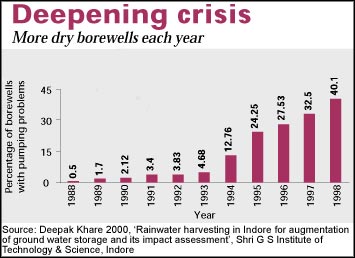Tunnel vision
 The onset of summer saw 27 borewells in Madhya Pradesh's Indore city dry up. On the face of it, the development is baffling because Indore is considered one of the pioneers of rainwater harvesting (rwh). Not only was it among the first places to adopt the system on a wide scale, it also introduced various innovations and incentives to ensure its success. Now, with the city's water table depleting alarmingly, the question being raised is: does rwh really recharge aquifers? The answer, of course, is yes. But the experience of Indore underscores the fact that rwh should be complemented by other water management practices.
The onset of summer saw 27 borewells in Madhya Pradesh's Indore city dry up. On the face of it, the development is baffling because Indore is considered one of the pioneers of rainwater harvesting (rwh). Not only was it among the first places to adopt the system on a wide scale, it also introduced various innovations and incentives to ensure its success. Now, with the city's water table depleting alarmingly, the question being raised is: does rwh really recharge aquifers? The answer, of course, is yes. But the experience of Indore underscores the fact that rwh should be complemented by other water management practices.
According to the Indore Municipal Corporation (imc) and Central Ground Water Board (cgwb), while there are around 1,000 rwh structures in Delhi, their number in Indore is about 3,000. Yet the latter's groundwater level has dipped by 4 metres in the past 20 years, points out a cgwb study. Consequently, several borewells are rendered redundant every year. "Though efforts to promote rwh began in 1999, the city did not have a good monsoon until 2003. This is also a reason for the drying up of borewells,' reveals V N Shroff, advisor, Rajiv Gandhi Watershed Management Mission. Besides, Indore has emerged as the commercial capital of the state, leading to increased exploitation of surface and groundwater.
Parched city Narmada river, sited 70 kilometres from Indore, is the main source of water for the urban areas of Indore. The Yashwant Sagar lake and the Bilawali tank also supply some amount of water. In order to carry the Narmada's water to Indore, a Rs 500-crore pipewater project was undertaken sometime ago. The first of the three phases of this project was completed in 1978. But the venture is not proving cost-effective. "The municipality earns Rs 10 crore, but spends Rs 33 crore. Also, the imc sells water at a subsidised rate. After the Narmada phase-3 interim project is commissioned, the annual running and maintenance expenditure may increase to Rs 90 crore,' points out V K Jain, chairperson, Madhya Pradesh State Pollution Control and Prevention Board.
Moreover, the river currently provides only 150 million litres per day (mld) of water to Indore
